




Electric Kettles



A chronology of the development of the electric kettle 1901 -
1901 Wilhelm Friedrich Schindler applies for patent for separate, coiled resistance element, wound on mica or asbestos disc, held by spider attached to the bottom of the vessel and not enamelled or cemented to the base of the kettle.
Patent GB190105487 granted 16.01.1902
1901 GEC electric kettle on stand
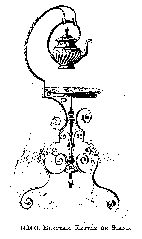 Electrical Review Vol. IL 8th November 1901 pp760
Electrical Review Vol. IL 8th November 1901 pp760
c.1901 Experiments carried out in Germany in depositing gold and platinum film elements on the bottom of enamelled saucepans. Very high resistances were obtained and good heat distribution. However, it was rather expensive as the enamel was liable to crack during firing and consequently, damage the metallic film with it. These experiments led to the development of the Prometheus system.
The Electrical Review vol. CXVII 11th October 1935 pp484
1901 Messrs Isenthal & Co. Rapid Jug Kettles Manufactured under the Schindler-
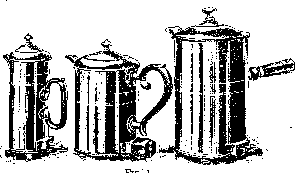
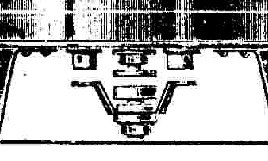
Electrical Review vol. IL 8th November 1901 pp765
These peculiarity of these kettles was the extra heating element around the side of the kettle, they had therefore to be filled to the level of the lateral heater but they boiled more quickly than a conventional type, ie.the ¾ pint boiled in five minutes the 1¾ pint and the 2½ pint models boiled in nine minutes. The kettles could be fitted with the cut-
1902 Mr Collins (later managing director of Premier Electric Heating Co. Ltd.), was sent to Germany to learn the details of the Prometheus system. On his return a factory was established at Kingston-
The Electrical Review vol. CXVII 11th October 1935 pp484
c1902 GEC “Archer System” Kettle. The ”Archer System” refers to the boil-
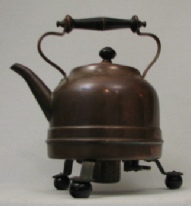
R.Saunders (private collection)
1903 British Prometheus Co. 3pt copper kettle. ( Prometheus was a trade mark of Dowsing)
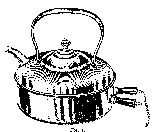
The Electrical Review vol. LIII 30th October 1903 pp696
1904 Prometheus 1½ pt. Brass kettle taking 9minutes to raise 1pt water from 60 deg C to boiling.
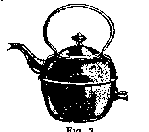
The Electrical Review vol. LV 23rd September 1904 pp 493
1904 The Simplex Electric Heating Co. of Cambridge Massachusetts, were enamelling Cupro–Nickel wires to the base of glue pots etc.
The Electrical Review vol. LV 11th November 1904
1905 14th February. George James Gray applied for a patent in which an electric kettle could be switched on by a time clock and, when boiling, the water would be forced into a cup, which when heavy enough will operate a balance connected to a switch, so that the electricity is removed from the kettle and transferred to an alarm. Possibly the first electric automatic tea-
Patent No. GB190503047 published 1906 – 02 -
c1905 Prometheus Kettle

R. Saunders (private collection) This kettle has been modified, at some time during it’s life, in order to accept a later conventional flat two pin socket, however the position of the original three separate pin connectors are still obvious.
1905 Hoskins Manufacturing Co. Detroit developed Nichrome. Patent GB19062129, but endorsed with a reference to Patent GB1896202
The Electrical Review vol. 69 October 6th 1911
1905 The cheapest electric kettle costs about £1.4.00, repairs to kettles typically cost 10s. These prices are holding back the electric heating and cooking boom, not the cost of supply, reportedly soon to be reduced to 1d per unit
(Don’t forget 240d = 20s = £1.00.00 = £1.00)
Letter from Mr E. Stanley Harpham. Published in The Electrical Review vol LVII 1905 pp 712
c1905 Prometheus kettle
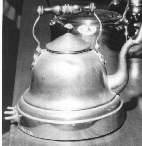 Photographed by Apex Photos Ltd. in 1966, possibly for the EDA. (Photograph in the Milne Collection at Amberley Working Museum,)
Photographed by Apex Photos Ltd. in 1966, possibly for the EDA. (Photograph in the Milne Collection at Amberley Working Museum,)
1906 March. British Prometheus Co. move from Kingston-
The Electrical Review vol. LIX 9th November 1906
1906 Range of “Electra” appliances from Messrs Isenthal & Co. used on board the Royal train when taken to India.
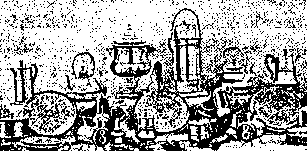 The Electrical Review Vol. 58 6th April 1906 pp540
The Electrical Review Vol. 58 6th April 1906 pp540
c.1906 Prometheus Kettle on Wrought Iron Stand
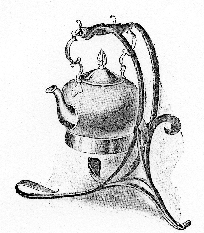
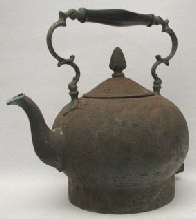
“Electricity applied to Light and Power” Drake & Gorham Ltd., and R.Saunders (private collection) sadly missing its stand and very rusty, it looks like a plated kettle on steel.
1906 Prometheus Jug Kettle

The Electrical Review vol.59 28th September 1906 pp489
c1906 Prometheus Jug Kettle
The Milne Collection, Amberley Working Museum. (See Illus. Electrical Review vol.58 pp540 (Handle style) and Electrical Review vol.59 pp751 (body shape). This kettle is fitted with three plugs for three different combinations of heating facility. i.e.: Boiling, simmering and keep hot.
1907 Bakelite patented in USA but not widely used until 1920’s
1907 The Premier Electric Heating Co. Formed in the UK.
The Electrical Review vol CXVII 11th October 1935 pp484
1907 General Electric (USA) developed a “full line of heating and cooking devices”.
http://www.ge.com/en/company/companyinfo/ataglance/historystory.htm
1908 24th February.

Benjamin Joseph Barnard applies for a patent for a coffee percolator, incorporating an electric element and a two chamber fountain. Water is heated in the lower chamber, to boiling point, then forced up a tube into the upper chamber where it is deflected over the coffee grounds.
Patent No. GB 190804134 granted 29th October 1908
1908 16th May The British Prometheus Company apply for a patent for their “boil-
1908 10th October. The British Prometheus Co. applies for a patent for a heater in which a resistance wire is wound on a mica former, or a resistance paint is painted on a mica former, and this is then enclosed in a thin steel case for protection. By bolting this construction to the base of cooking vessels it thus paves the way for a truly replaceable element. Patent No. GB190821493. Granted 7th January 1909
c1908 Verity – Aston kettle.
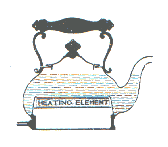 Verity – Aston Catalogue c1908 pp338, in the Milne collection.
Verity – Aston Catalogue c1908 pp338, in the Milne collection.
Showing method of construction (semi-
c1908 Verity – Aston kettles

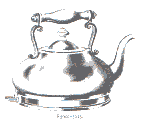


(1) (2) (3) (4)
These kettles are illustrated in the Verity’s catalogue c1908 in the Milne collection at Amberley Working Museum. Fig 1 is a copper kettle with white porcelain handle and knob, available in: copper nickel or brass finish, aluminium lined; 1 or 2 pint and taking 10 or 20 minutes to boil. Fig 2 is similar to fig 1 but is 4 or 8 pint and takes 23 or 26 minutes to boil. Fig 3 is a 2.1/2 pint kettle with wrought iron handle and available as copper and iron or silver plated, takes 20 minutes to boil. Fig 4 is a burnished tinplate kettle in 2 pint size taking 15 minutes to boil.
c1908 Verity – Aston Jug kettles
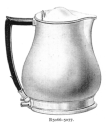
Verity – Aston Catalogue c1908 pp348, in the Milne collection.
These kettles were available in various models encompassing every number between R5058 and R5077. Two voltage ranges of 100 – 110 and 200 – 250 were available along with finishes in either Brass & Copper or Nickel. Sizes ranged from 1pt to 3pt and power ratings were 320W for the smaller kettles up to 1200W for the largest. Prices are quoted between 18/9d for the smallest kettle finished in Brass & Copper up to £1.17.6d for the largest finished in Nickel. All kettles had Aluminium linings and turned cast base rings and mounts. Replacement elements were available, priced at 1/6d for the lowest wattage up to 2/9d for the largest.
c1909 AEG Kettle (Designer Peter Behrens)
Oval form
Round form (also available as round form smooth)
Octagonal form
“Peter Behrens und die AEG 1907 -
These kettles were available in three styles with three finishes giving nine designs in all. (Included to show what appears to be the 1st conventional immersed element, although it is likely that it is a resistance wire element, wrapped on mica sheet, slid into a tube which was then immersed in the water). As these kettles fetch such a lot of money I have yet to examine one carefully and our sole example at the Milne has had a conventional modern element fitted at some time in it’s life.
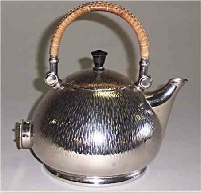
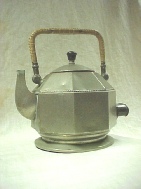
Although the AEG kettles were not generally available to the English market, a remarkably similar kettle called “The Beehive” was available, post war in 1919, from Belling & Co. See 1911 -
The author has seen other kettles similar to the AEG round form, marked with the name “Cehal”, however no documentary evidence of this kettle has yet been discovered). Offered for sale on ebay 2005-
Also a Graetzor kettle also offered for sale on ebay. Again documentary evidence for this kettle is currently missing.
These more modern kettles differ markedly from the AEG, in that the element appears to be of the bolt under type, whereas the AEG elements appear to be immersed, the base, in consequence, is much larger and is perforated to dissipate heat. Further, the lid knob appears to be more pointed than the conventional AEG. Comparison is invited with the Belling “Beehive” kettle of 1919. These kettles are all dealt with in the1911 -
1909 27th May
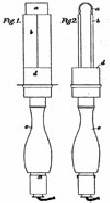
Two views of George Cooper and Chester Sharp’s immersion heater. George Cooper was the Managing Director of The British Prometheus Co. Ltd. Careful study of these drawings will show the similarities with the “Swan” Companies “1st” immersed element in 1922. Patent No. GB 190821493
1910 Simplex kettle advert. (Simplex Conduits Ltd. 113 – 7 Charing Cross Road, LONDON WC. Works at Garrison Lane Birmingham.)
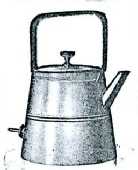
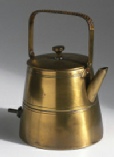
Watford Electrical Bulletin No. 2 c.July 1910 The National Museum of Science & Industry’s website.
1910 Unidentified kettle
used to illustrate an article equating the cost of the kettle with a pair of shoes and suggesting that Ladies should forgo messing around with spirit kettles, at afternoon tea, in favour of the new electrical kettle.
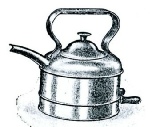 The Watford Bulletin No. 2 pp2 c. July 1910
The Watford Bulletin No. 2 pp2 c. July 1910
1910 Unidentified kettle, used in an illustration of an oven and distribution board.
 The Electrical Review vol. LXVII 10th August 1910 pp292
The Electrical Review vol. LXVII 10th August 1910 pp292
1910 Therma System 2pt Kettle. Armourduct Manufacturing Company Ltd. of Farringdon Avenue, LONDON EC. The first? use of Nickel Steel alloy coated in non-
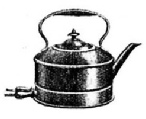 The Electrical Review vol.LXVII 2nd September 1910 pp.373
The Electrical Review vol.LXVII 2nd September 1910 pp.373
1910 GEC “Magnet” CAPTAIN kettle model H3616. from an advert titled “Table cooking by electricity” GEC “Magnet” System. Available in 2pt at 24/-
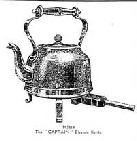
The Watford electrical bulletin c.October 1910 add picture of John’s early Captain Kettle
1910 Unidentified kettle is part of a Photograph entitled “A model electric drawing room” and formed part of the exhibit of Glasgow Corporation Electricity Department at the Smoke Abatement Exhibition held in Glasgow. This part of the photograph is indicated as “Electric kettle on tripod”.
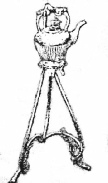 The Watford Electrical Bulletin No.3 c.October 1910 (Computer enhanced)
The Watford Electrical Bulletin No.3 c.October 1910 (Computer enhanced)
1910 British Thomson – Houston kettle on stand
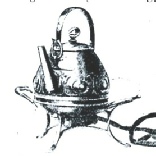 The Watford Electrical Bulletin No. 3 c.October 1910
The Watford Electrical Bulletin No. 3 c.October 1910
1910 Mr F. H. Williams joined Messrs T & J Jackson (later to become The Jackson Electric Stove Co. Ltd.) and started a heating & cooking department including the manufacture of electric kettles.
No illustration
The Electrical Review September 24th 1920 pp389
Kettles are still fairly rare from this decade however look for kettles where there is no obvious way in to the element, indicating that the element is permanently fixed to the base.
Kettle pins were rarely shrouded and almost never earthed. The third pin is usually an indication of a keep hot element, engaged by repositioning the individual connector plugs.

The early years of the 20th Century marked the coming of the electric kettle into the main stream of domestic appliances, although still only affordable by the well off, kettles being irrepairable at the beginning of the decade were largely capable of being repaired by the end of the decade.
Kettle design still reflects the type of use to which it was to be put, with ornate highly polished kettles intended for use by the lady of the house differing markedly from the purely functional kettle intended for use “below stairs”.
Credibility was given to all manner of electrical appliances when it became known that the Royal Family had taken many electrical items on their tour of India, for use on the Royal Train.
A true AEG kettle, round form, once offered for sale by auction on the internet.
A true AEG octagonal form, sadly crudely modified to accept a more modern element. The Milne Collection at Amberley Working Museum.
